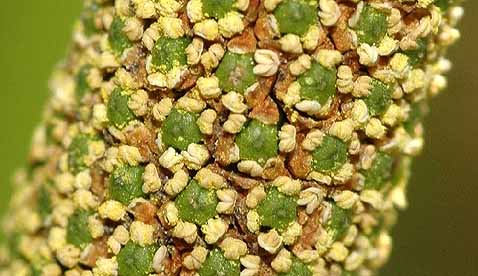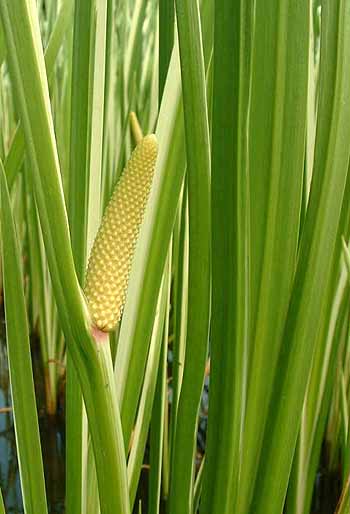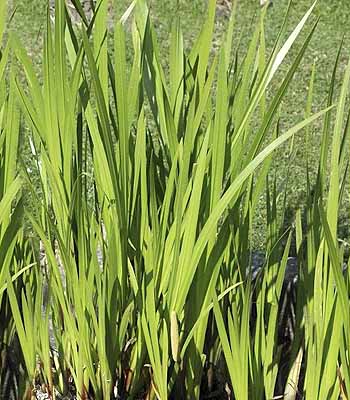Sweet flag is a great wetland or boggy area plant. It is hardy to zone 3 and not really fussy about soil type. It does best with good rich soil but it will grow in other conditions. It cannot tolerate getting dry. Ideal for boggy areas, sides of streams or in ponds. Will spread rapidly once established and needs little if any care. The whole plant has a lovely aroma and the roots are edible. Not suitable for rain gardens as they tend to dry out at times. We don't think the deer eat it but cant be certain.
Sweet flag has a spreading rootstock from which every spring a tuft of basal leaves emerge. They are sword shaped, flattened with one wavy edge and a prominent midrib with other parallel veins. These leaves are about ¾" (2 cm) wide and up to 4 feet (122 cm) tall, and fairly bright green. In late spring some leaves develop a 'flower' which is a cylindrical spadix, usually 2-4" (5-10 cm) long and semi erect and just below the leaf tips. This spadix is covered with tiny greenish yellow flowers in a diamond-shaped pattern. Flowers last for about a month and are very sweet scented. Sweet flag is pollinated by insects, which ones is not precisely known. However although these occur in the United States and its original home in India and Asia they do not appear to be present in Europe. Hence the plant does not produce fruit in that continent. Where it is pollinated the fruit is a tiny greenish berry which is sparingly produced. The whole plant is aromatic and emits a pleasant aroma when bruised. It is hardy to zone 3.
For best results ensure that the soil has plenty of organic material dug into it. Plant out slightly below the soil surface in moist soils or at the water's edge. The leaf tips will scorch if the soils dry out. Plant about 10 inches (25 cm) apart. When established the plants will grow rapidly and spread out.
Plant spread will only be limited by the size of the wetland. If containment is required plant in containers to prevent sweet flag from taking over the area. Sweet flag is very hardy, easily to zone 3. It dies down and goes dormant every winter. Provided that the plants do not dry out sweet flag needs almost no additional care or maintenance. Just plant and enjoy.
Due to recent developments in research into this species as well as Acornus calamus this section is being re-written.








